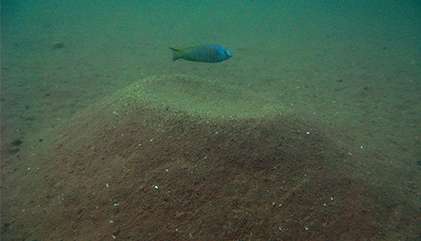Cichlid fish building sandcastles
(Phys.org) —In Lake Malawi, East Africa, there are around 200 different species of cichlid fish that once or twice a year build large sand structures (known as bowers) on which the fish mate. Each different species constructs a bower which is subtly different to that of other species. The males then defend their 'sandcastle', hoping to attract the attention of the opposite sex.
Now, researchers at the University of Hull and the University of Nottingham have found that the precise shape of the bowers affects how many fights the male fish have with their nearby rivals.
The findings may explain how there came to be so many different species of bower-building cichlid living along-side one another.
Dr Domino Joyce, Senior Lecturer in Evolutionary Biology at the University of Hull, explained how the team conducted the research:
"We spent a total of 26 and a half hours underwater, watching 99 cichlid fish of one particular species.
"In order to investigate the importance of bower shape, we carefully changed the sand structures of some of the fish. When we did this, we were fascinated to find that the owners of these bowers got into fewer fights with other males.
"This is exciting, because it suggests that if male fish evolve to build their castles a little bit different to the others of their species, then these males may have an advantage as they are less likely to get attacked."
The team of scientists recorded both mating success and aggressive interactions before and after manipulation of the bowers. Importantly, whilst aggression was reduced, altering bower shape did not 'put off' females from mating with these males.
"This is vital, because if females are deterred from mating with males who build novel shaped bowers, then the fact that these males are subjected to less aggression from other males, would be no advantage at all," said Dr Magalhaes, Research Fellow at the University of Nottingham and lead author of the research.
"Our research shows that different behaviours can co-exist within a population. Owners of novel bowers should be able to occupy central territories, experience less aggression from other males and successfully mate with females.
"Over time, if female preference also evolves to favour the new shape of bower, then this could lead to the emergence of a new species of cichlid, all of whom build this once novel style of sandcastle."
Increasing understanding of how one species evolves into several other species, particularly within the same environment, can help tell us more about the diversity of life on Earth. This new research, published this week in the journal PeerJ, may help to explain how there came to be so many different species of bower-building cichlid fish living in Lake Malawi.
More information: Magalhaes IS, Croft GE, Joyce DA. (2013) Altering an extended phenotype reduces intraspecific male aggression and can maintain diversity in cichlid fish. PeerJ 1:e209 dx.doi.org/10.7717/peerj.209
Journal information: PeerJ
Provided by University of Hull























